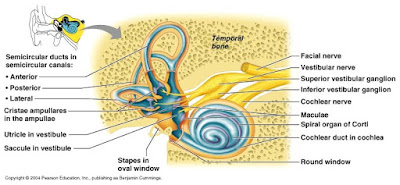 The static labyrinth evaluates head position shift or acceleration and deceleration and translates that into data about the position of your body. In the vestibule, you will find the utricle and saccule. Within the utricle and saccule, you will find the maculae, which are the sensory structures. There, there are hair cells nestled within support cells. On top of the hair cells, there is stereocilia and kinocilia. On top of that are otoliths within the gelatinous otolithic matrix. This matrix shifts based on the position of the head. Movement of the matrix is detected by hair cells. Displacement of the stereocilia in the direction toward the tallest stereocilia causes depolarization of the afferents. Displacement of the stereocilia toward the shortest stereocilia causes hyperpolarization of the afferents. The vestibular nuclei coordinate spinal posture. The somatosensory cortex processes the information gathered by the static labyrinth. Signals are sent to the cerebellum and relay as muscle movements in the head and eyes.
The static labyrinth evaluates head position shift or acceleration and deceleration and translates that into data about the position of your body. In the vestibule, you will find the utricle and saccule. Within the utricle and saccule, you will find the maculae, which are the sensory structures. There, there are hair cells nestled within support cells. On top of the hair cells, there is stereocilia and kinocilia. On top of that are otoliths within the gelatinous otolithic matrix. This matrix shifts based on the position of the head. Movement of the matrix is detected by hair cells. Displacement of the stereocilia in the direction toward the tallest stereocilia causes depolarization of the afferents. Displacement of the stereocilia toward the shortest stereocilia causes hyperpolarization of the afferents. The vestibular nuclei coordinate spinal posture. The somatosensory cortex processes the information gathered by the static labyrinth. Signals are sent to the cerebellum and relay as muscle movements in the head and eyes.
Sunday, November 6, 2016
The Static Labyrinth: Linear Acceleration
 The static labyrinth evaluates head position shift or acceleration and deceleration and translates that into data about the position of your body. In the vestibule, you will find the utricle and saccule. Within the utricle and saccule, you will find the maculae, which are the sensory structures. There, there are hair cells nestled within support cells. On top of the hair cells, there is stereocilia and kinocilia. On top of that are otoliths within the gelatinous otolithic matrix. This matrix shifts based on the position of the head. Movement of the matrix is detected by hair cells. Displacement of the stereocilia in the direction toward the tallest stereocilia causes depolarization of the afferents. Displacement of the stereocilia toward the shortest stereocilia causes hyperpolarization of the afferents. The vestibular nuclei coordinate spinal posture. The somatosensory cortex processes the information gathered by the static labyrinth. Signals are sent to the cerebellum and relay as muscle movements in the head and eyes.
The static labyrinth evaluates head position shift or acceleration and deceleration and translates that into data about the position of your body. In the vestibule, you will find the utricle and saccule. Within the utricle and saccule, you will find the maculae, which are the sensory structures. There, there are hair cells nestled within support cells. On top of the hair cells, there is stereocilia and kinocilia. On top of that are otoliths within the gelatinous otolithic matrix. This matrix shifts based on the position of the head. Movement of the matrix is detected by hair cells. Displacement of the stereocilia in the direction toward the tallest stereocilia causes depolarization of the afferents. Displacement of the stereocilia toward the shortest stereocilia causes hyperpolarization of the afferents. The vestibular nuclei coordinate spinal posture. The somatosensory cortex processes the information gathered by the static labyrinth. Signals are sent to the cerebellum and relay as muscle movements in the head and eyes.
Subscribe to:
Post Comments (Atom)
Designed By Templateism | Seo Blogger Templates

No comments:
Post a Comment